All three-dimensional shapes, as the name suggest, have three dimensions.
3D shapes which are prisms have a length, width and height.
3D shapes which are non-prisms have a radius, height and circumference.
There are a number of other features which can be helpful when identifying and working with 3D shapes:
1) Corners / Vertices:
Prisms can also be identified by the number of vertex they have.
Vertex is the mathematical name for a corner.
The plural of vertex can be vertices or vertexes (if we are talking about more than one).
2) Edges:
Prisms can also be identified by their number of edges.
3) Faces:
And finally, prisms can be identified by their number of faces.
A sphere is slightly different, as it has one smooth surface.
The key fact to remember here is that every point on the surface of a sphere will be the same distance from the centre.
Now it's over to you to put this information into practice!
In this activity, we will recognise and apply geometric terms and notations to help us solve problems involving 3D shapes.












